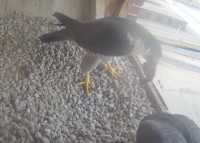Lawrence Peregrines: food exchange
April 1, 2018 in In the Nest Box, Peregrine Falcons Eastern Massachusetts, Peregrine Falcons Massachusetts
 Happy Easter! The peregrine falcons were seen on Easter morning while engaged in a classic food exchange, under cloudy skies, winds from the SW at 15MPH, and gusts up to 23MPH, and temps in mid-fifties. For many this morning was filled with hopes of a first egg, but not quite yet! Here’s a bit of background on food exchanges among large falcons:
Happy Easter! The peregrine falcons were seen on Easter morning while engaged in a classic food exchange, under cloudy skies, winds from the SW at 15MPH, and gusts up to 23MPH, and temps in mid-fifties. For many this morning was filled with hopes of a first egg, but not quite yet! Here’s a bit of background on food exchanges among large falcons:
Food-Transfer Display: A common courtship display involves the transfer of food from one mate to the other, usually male to female. Either sex may initiate a transfer.The female uses a wail vocalization or rarely a whine, combined with a vertical head-low posture to solicit transfers when the male does not have food. If the male has food, the wail and Ee-chip vocalizations are used about equally by the female, often accompanied by the vertical Head-Low BowDisplay.
Male solicitation which elicits the female’s approach always occurs when he has food, either spontaneously or initiated by female intention movements to engage in transfer.This solicitation by the male is characterized by a very sharp and clear Eechip vocalization. The male alternates between a relaxed posture, with the head up, and a posture with his head down while he manipulates or contacts the prey item. This posture,with the head low, does not appear to be the nonaggressive Head-Low BowDisplay. Transfer from the female to the male is not obviously solicited.
Prior to actual transfer, the male picks the prey item up in his beak and stands vertically, head up. The female maintains head-low postures, often horizontal, and both sexes give complete Eechip vocalizations.
Literature Cited:
Cade, T. J., J. H. Enderson and J. Linthicum. 1996a. Guide to Management of Peregrine Falcons at the eyrie. Boise, ID: The Peregrine Fund, Inc. (Excerpt: Linthicum, Janet. Observing Breeding Behavior)
Wrege, P. H. and T. J. Cade. 1977. Courtship behavior of large falcons in captivity. Raptor Res. no. 11:1-46.
